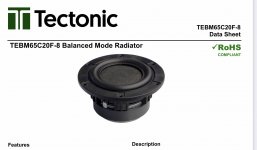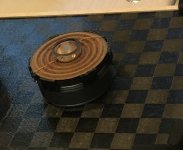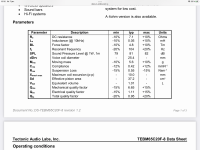Sorry i’ve missed to describe the exciters.Excellent! Apologies if you've already answered these questions, but I did try to skim all the posts.
What are those exciters? (Cant imagine this has not been stated but I didn't find it)
How did you mount the unit in the wall cavity and isolate it from the wall frame? Any photos inside the wall pre-installation?
Im a bit late to this party as I took a breather from the forum (shall we call it counting to ten?).
They are modified drivers from tectonic. I needed an exciter that had close to 10 mm xmax and strong enough to drive the panel in piston mode. I couldn’t find a regular exciter with this specification. The modification is easy to do. The chassi is made of plastic.
Attachments
I thought it was 5mm Xmax?Sorry i’ve missed to describe the exciters.
They are modified drivers from tectonic. I needed an exciter that had close to 10 mm xmax and strong enough to drive the panel in piston mode. I couldn’t find a regular exciter with this specification. The modification is easy to do. The chassi is made of plastic.
That’s a bit clearer now. I was thinking of one panel connected in phase and the with phase reversed, but you said pair of panels. Can you give a reference that discusses this technique?Let's try as I understand it: if you carefully read the explanation on Goebel's website at my link, you should have paid attention to the concepts of coincidence frequency - this is the frequency at which the phase velocity of the bending wave becomes equal in value to the phase velocity in air. And thus, from this moment, the piston mode of operation of the membrane begins to appear. Moreover, this process does not occur abruptly, but gradually with a further decrease in frequency. The measurement graph of panels connected out of phase as a whole has a lower sound pressure, which is quite logical due to mutual subtraction. But there is no subtraction at the coincidence frequency point, and therefore the pressure at this point is the same. In this case, it is a point with a value of 1.7 kHz.
The exciters on the panels are on the reverse side of the microphone, but in theory this does not matter for the observed effect.
Thanks. To be clear, I wasn't criticising you for not stating it, only that I expected that it had been stated, and that I was most likely asking for it again. 🙂Sorry i’ve missed to describe the exciters.
They are modified drivers from tectonic. I needed an exciter that had close to 10 mm xmax and strong enough to drive the panel in piston mode. I couldn’t find a regular exciter with this specification. The modification is easy to do. The chassi is made of plastic.
The idea of such a measurement came to my mind after I read Veleric's postCan you give a reference that discusses this technique?
The BMR voice coil is so thin it will not hold up the magnets weight therefore you must use a frame and spine to hold the magnets weight in place. Although exciters were designed to hold the magnets weight they will benefit from using a frame and spine especially with the larger/heavier exciters.View attachment 1127291
Top is a BMR driver I took apart. Bottom is a exciter. See how thin the voice coil of the BMR is compared to the thick plastic of the exciter.
This is the reason why I say you should build it like a BMR driver with a frame and a spine to hold the magnet in place with some sort of surround material to hold the diaphragm in place as everything will be supported.
Last edited:
Alvipet,The measurement graph of panels connected out of phase as a whole has a lower sound pressure, which is quite logical due to mutual subtraction. But there is no subtraction at the coincidence frequency point, and therefore the pressure at this point is the same. In this case, it is a point with a value of 1.7 kHz.
Very interesting, I will have to try it! Though I am still not yet sure I understand the theory behind the measurement, it's sure easy to try.
Can you describe the panel in your measurements? Thickness(es), materials?
Thanks,
Eric
2 good points in this spec : the resistance (7Ohms) and the inductance (0.05mH) compare to more usual 4 Ohm, 0.1mH at the best so the current and then the force will be maintained further in the frequency range. BL is good not excellent10mm p-p from the data sheet. It’s stated as x mech max. Which most likely means its not perfectly linear in the whole range.View attachment 1127307
Good also to have holes at the top of the voice coil to allow the air escaping hopefully with no or little noise.
Last edited:
Just normal cardboard with an extra layer of corrugated cardboard, 3 exciters used 2 cheap 25mm wired in series and one 32mm in parrel , ribbon crossed at 2400khz , cardboard supported both sides, I cut a slot the length of the two 2"X2" for the cardboard to be slotted down, see my video I've just posted on here, phone recording but you get the idea.Yes, please describe what you did to prepare the stiff cardboard for the panel? And, anything and everything relevant. 🙂
Thanks!Thomas this is very excellent indeed. Well done Sir! Those distortion measurements are amazing!
I also suspected that (because of the high driver/panel ratio) your panels can only operate as pistons for the lower part of the spectrum. But this also exposes the surprisingly flat responses of those exciters due to your close-miked measurements. It appears that the "break up"(?) beyond 1.5khz might be due to a combination of acoustic combing as well as panel resonances due to the symmetrical spacing of the drivers.
Are you able to do off-axis measurements to confirm DML action at higher frequencies? Do your panels sound the same whether on-axis or off-axis?
yes, they do sound the same off axis.
Yes, I can do measurement, soon.
Speaker thickness about 40 mm, materials - plywood, honeycomb radiating membrane. Here they areCan you describe the panel in your measurements? Thickness(es), materials?
Sorry, I couldn't reply earlier. Only just now the guests left. Thank you very much for the Karavashkin link. Oh, I made a mistake with the word epoxy. I was thinking about the stabilizing impregnating composition based on polyurethane primers and varnishes covering surface layers. So, what might be the weight of the honeycomb panel after the treatment of polyurethane primers and varnishes both surface layers. An approximate value is enough. Oh, what might be the thickness of that membrane?Well, you have already studied them deeply enough). I can give a lost link to the work of the Karavashkins .
We do not use epoxy resin in our products, so I have no answer to this question.
I have gone back to read Henry Azima's thoughts again, now with a different outlook, that is, after reading Herger's patents and Gobel's patent (from @Sandasnickaren link), I have a sudden feeling that I'd build a fully enclosed DM speaker, sometime in the late spring or summer. If it's going to be omnidirectional in the far field, I'd be quite content. If it stays between 50Hz to 15kHz, it'd be quite alright. I don't think my hearing would reach that much, but my wife may hear better. True, I've studied the patents deeply. I have some more to read, though. 🙂 I have given the links and translated some excerpts for others here to study them too, that is, if they want to.
Last edited:
Thank you for the link Alvipet.Speaker thickness about 40 mm, materials - plywood, honeycomb radiating membrane. Here they are
Are the bass from the panels?
I was wondering about the device below? To make my question more clear : I am wondering about which sub to help panels and I have crossed the "Ripole" (2 woofers oriented like that and load by a slot). Having them in separated boxes may help in trimming the system?
Other questions : about the way to record. You use here a Tascam05.
How is the sound level in the room? I know a bit difficult to answer... low, high as usual, very high?
Have you experience with other recorders (Zoom H1n for example)?
Are there some rules to get a record similar to the sound in the room?
Christian
For monitors as in the video at the link, the weight of the membrane is within 50-70 grams, the thickness is 3 mmSo, what might be the weight of the honeycomb panel after the treatment of polyurethane primers and varnishes both surface layers. An approximate value is enough. Oh, what might be the thickness of that membrane?
Thanks!For monitors as in the video at the link, the weight of the membrane is within 50-70 grams, the thickness is 3 mm
Sorry, I didn't reply earlier. Too many guests at home.Just normal cardboard with an extra layer of corrugated cardboard, 3 exciters used 2 cheap 25mm wired in series and one 32mm in parrel , ribbon crossed at 2400khz , cardboard supported both sides, I cut a slot the length of the two 2"X2" for the cardboard to be slotted down, see my video I've just posted on here, phone recording but you get the idea.
Can you please post few images? And dimensions, etc?
Alvipet,For monitors as in the video at the link, the weight of the membrane is within 50-70 grams, the thickness is 3 mm
When I asked for the panel thickness before you replied 40 mm, which seemed rather thick! But I guess you thought I meant the whole speaker.
Actually, what I was trying to get at was enough information to take a reasonable guess at what the coincidence frequency "should" be, based on the details of construction of the panel, and their thicknesses, then I could compare that to your measured result of 1.7 kHz
So far, what I understand is that the whole panel is 3 mm, and is constructed of "plywood" with a honeycomb core, is that correct?
Could you share more details about the construction?
Perhaps the honeycomb core is nomex? How thick?
And what is the thickness of the outer layers of wood, and how many plies are in each of them?
I understand if this is more detail than you want to share....
Thanks
Eric
On video panels work together with PPD subs. They are not quite "Repole". You can read about them here . On their own, the panels provide a linear frequency response down to 50 Hz.Are the bass from the panels?
The SPL level in the room is around 75-80 dB during recording. Besides Taskam 05, I also sometimes use the Zoom H4n. But in comparison with Taskam, it records in low frequencies not so thoroughly. I am not an expert in sound recording and therefore I can hardly give you exhaustive advice in this matter.)
- Home
- Loudspeakers
- Full Range
- A Study of DMLs as a Full Range Speaker


